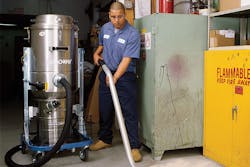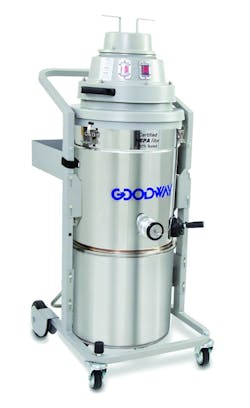While facility managers juggle multiple responsibilities, one task that should take top priority is ensuring a safe work environment for all employees. Safety encompasses many different things within a factory or production facility, but properly collecting combustible dust ranks high on the to-do list. History has proven airborne particles can be extremely hazardous, resulting in deadly explosions and fires at processing and manufacturing plants.
A study done by the U.S. Chemical Safety and Hazard Investigation Board looked at 105 incidents from 2007 to 2018 where dust was involved in an explosion or fire. The industries with the highest number of dust incidents included food products, metals and lumber. However, that doesn’t mean other sectors can neglect taking proper precautionary steps.
Any processing facility that produces airborne material should consider an investment in a certified industrial hazardous material pickup vacuum, sometimes referred to as "explosion proof." According to the Occupational Safety & Health Administration (OHSA), "A combustible dust explosion hazard may exist in a variety of industries, including: food (e.g., candy, starch, flour, feed), plastics, wood, rubber, furniture, textiles, pesticides, pharmaceuticals, dyes, coal, metals (e.g., aluminum, chromium, iron, magnesium and zinc), 3D welding (a form of 3D printing) and fossil fuel power generation. The vast majority of natural and synthetic organic materials, as well as some metals, can form combustible dust."
One way to reduce the risk of a combustible explosion is to safely collect and eliminate combustible dust from the work area. A practical and efficient solution for facility managers to meet this cleaning need is a specialized industrial vacuum cleaner that meets specific certifications. However, before purchasing just any industrial vacuum cleaner, facility managers should ask themselves a few questions to find the best solution to meet their facility guidelines.
Goodway Technologies’ VAC-EX-120-9-SS is designed for collecting dry, combustible powders such as flour, sugar and additives. All images courtesy of Goodway Technologies
1. What is the application?
With any maintenance equipment, it is important to consider the environment and find a solution that is designed specifically for the task. At the start of the process of potentially purchasing an "explosion-proof" vacuum, think about the type of materials that need to be cleaned up. Some models may be better suited for certain types of hazardous/flammable materials, which may be in light powders or combustible liquids. It’s important to select an industrial vacuum cleaner that will meet specific certifications.
2. What type of filtration system is required?
Many facility managers often question what kind of filter is best for an industrial vacuum for dry pickup. The answer may vary among industries, as some environments need to adhere to stricter maintenance guidelines. Two types of filters are available — HEPA and ULPA.
According to OSHA, a HEPA, or high-efficiency particular air filter, is defined as a filter that is at least 99.97 percent efficient in removing particles of 0.3 micrometers in diameter. HEPA filters capture microscopic substances, such as dust mites and other airborne particles, that can be hazardous or produce health issues within a facility.
An ULPA, or ultra-low penetration air filter, is even more effective at capturing the smallest particles. These filters remove at least 99.99 percent of particles that are 0.12 micrometers in diameter. The high-quality filtering of ULPA is achieved by a slow filtering process that doesn’t exceed 0.025 micrometers per second. ULPA filters are most commonly used for cleanroom applications or environments where critical cleaning is vital.
3. How powerful is it?
A vacuum’s power isn’t based solely on the horsepower of the motor. When picking up dry materials, airflow is one of the most important details to consider. The speed of airflow is measured by cubic feet per minute (CFM) and this force collects particles and dust into the vacuum. A higher CFM increases the volume when picking up fine powders.
Another way to assess whether an industrial vacuum cleaner is powerful enough for the application is to measure the static lift. This is directly related to the power of the airflow and the ability of the industrial vacuum to lift heavier, more dense material. Picking up heavier metals requires higher lift specifications.
Tips for finding the right "explosion-proof" vacuum cleaner
There are some additional factors to keep in mind when considering an "explosion-proof" vacuum. Only purchase a vacuum cleaner that is certified by a reputable organization like UL, CSA or ETL.
Not only does the material that is being picked up and vacuumed make a difference, but so does the environment. All certified vacuums will clearly state a "Class," "Division" and "Group" category associated with the unit. These three classifications are clarified in the following section.
Class: Class refers to the type of combustible material that is being vacuumed.
- Class I is used to describe flammable gases and or vapors that may be found in petroleum refineries, airplane hangars or spray finishing areas.
- Class II is used to describe combustible dusts that may be found in grain elevators, flour mills or coal processing plants.
- Class III is used to describe easily ignitable fibers that may be found in textile plants or cotton mills.
Division: Division refers to the amount of combustible material that is present in the environment.
- Division 1 is used to describe environments where the combustible material is present every day during normal production operations.
- Division 2 refers to environments where it is abnormal for the combustible material to be present. With Division 2 areas, it’s assumed that the combustible material is expected to be confined within sealed containers and is only present to the open environment due to accidental spillage.
Group: Group refers to the specific types of combustible materials that will be vacuumed.
- Group A refers to gases and vapors like acetylene.
- Group B refers to a small segment of gases like hydrogen.
- Group C is used for ether.
- Group D is used for larger segments like gasoline, natural gas, propane and butane.
- Group E is used for metal dusts.
- Group F is used for carbon black and coal.
- Group G is used for grain, flour, cocoa and starch products.
Safety is the number one priority
Finding the right equipment to perform proper cleaning is just one piece of reducing the risk of a combustible explosion. Facility managers need to educate everyone who works closely to the source of the potential hazards about the precautionary steps that should be taken to improve safety measures.
Frank Intrieri Jr. is vice president at Goodway Technologies, a global manufacturer of specialized industrial maintenance products for a diverse list of markets including HVAC, energy, maritime, manufacturing and food and beverage production. Visit www.goodway.com for more information or call 800-333-7467.



